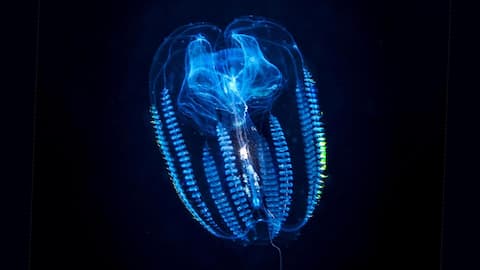Transparent sea walnut can defy aging! You read that right
What's the story
A recent study has revealed that the Atlantic comb jelly, also known as the "sea walnut," possesses an extraordinary ability to reverse its own aging process. This unique capability is triggered when food becomes scarce or the creature suffers an injury. In such circumstances, this gelatinous invertebrate can regress into its larval form, equipped with two tentacles for catching food.
Uniqueness
Sea walnut: A unique addition to reverse aging species
The sea walnut, scientifically known as Mnemiopsis leidyi, is the first-known comb jelly (Ctenophora) and the third-known animal species capable of reverting to an earlier life stage after reaching adulthood. The study, published in the preprint database BioRxiv, has yet to undergo peer review. Prior research had identified only two other species with similar capabilities: the immortal jellyfish (Turritopsis dohrnii) and the dog tapeworm (Echinococcus granulosus).
Implications
Sea walnut's age reversal: A widespread phenomenon?
The discovery of age reversal in comb jellies "confirms that reversal development might be more widespread than previously thought," according to the researchers. This study builds on previous work exploring the sea walnut's hardiness. The ability of these creatures to survive in harsh conditions, such as a lack of food, has led them to become an invasive species in various parts of the world, including Europe and Asia.
Invasion
Sea walnut's global spread and impact on fisheries
Originally native to the western Atlantic Ocean, the sea walnut has spread worldwide, becoming an invasive species in both Europe and Asia. Researchers believe that M. leidyi survived in the ballast water of ships for weeks without food, enabling their transatlantic journey. The species is now found in the Black and Caspian seas, where it competes with native creatures for food, contributing to the collapse of local fisheries. It has also invaded the Mediterranean, Baltic, and North seas.
Experiment
Uncovering the sea walnut's survival tactics
To understand the sea walnut's survival strategies, researchers conducted experiments involving starvation and physical injury. One group of comb jellies was starved while another was physically injured by removing tissue from their lobes. Despite shrinking into tiny blobs, these creatures did not die. When fed again, 13 out of 65 tested comb jellies grew tentacles, indicating a regression to their larval stage.
Regeneration
Sea walnut's regeneration: A new ecological niche
Marine biologist and postdoctoral fellow at the University of Bergen, Norway, Joan J. Soto-Angel, explained that the regressed jellies used their tentacles to capture food unavailable to them as adults, allowing them to exploit a new ecological niche. Once they had sufficient food, these comb jellies returned to their original size and regrew their lobes. Remarkably, they even regained their ability to reproduce, according to the study.
Discovery
Sea walnut's age reversal: A surprising discovery
Soto-Angel expressed that finding a third animal capable of aging in reverse "was quite a surprise." He noted that the process by which M. leidyi regresses to its larval form differs from how the immortal jellyfish does it. However, both animals could potentially help researchers gain a better understanding of aging. As one of the oldest extant animal lineages and potentially the sister group to all animals, comb jellies provide a unique model for studying evolution.
